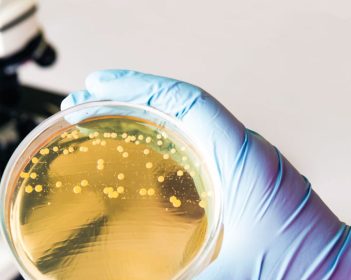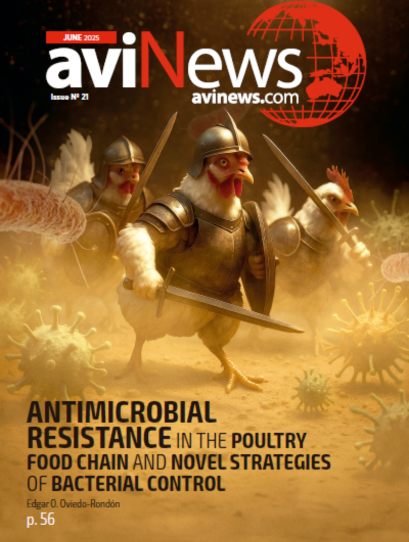Escherichia coli has long been underestimated, traditionally considered as an environmental and opportunistic agent in immunocompromised animals, or as a complicating agent in viral infections in poultry.
- However, for some years now, it has been considered a primary pathogen causing multi-million dollar losses worldwide, although it is difficult to estimate its real impact.
The economic impact has been related to a decrease in growth and seizures in the broiler processing plant, low production in laying hens, as well as an increase in mortality. Even when rearing conditions are inadequate, E. coli infections compromise bird welfare.
Escherichia coli was discovered in 1886 by Theodor Escherich, who found this microorganism in the feces of children. Since then, it has been considered a normal inhabitant of the intestinal biota of various animals and humans and plays a very important role in the digestion and regulation of the intestinal microbiota.
This bacterium belongs to the family Enterobacteriaceae, is gram negative, facultative anaerobic; it grows at temperatures between 15°C and 45°C, does not produce spores, can be motile or immotile and is normally a lactose fermenter, although there are strains that are not able to use this substrate.
This microorganism has been classified into three main groups:
- Commensal strain.
- Intestinal pathogenic strains (InPEC) or diarrheogenic strains.
- Extraintestinal pathogenic strains (ExPEC), depending on their pathogenic potential.
The latter group includes uropathogenic strains (UPEC), those causing bacterial meningitis (BMEC) and those causing infections in birds known as avian pathogens (APEC).
BIOCHEMICAL IDENTIFICATION
Traditionally, its identification in the laboratory is based on its biochemical properties (Figure 1) since sophisticated equipment is not required, however, given the diversity of this bacterium it is not sufficient to know the virulence of the strain in question, nor is it possible to differentiate between pathotypes.
- Therefore, other methods are required to elucidate whether a particular strain has the pathogenic capacity to cause an infectious problem in a flock.
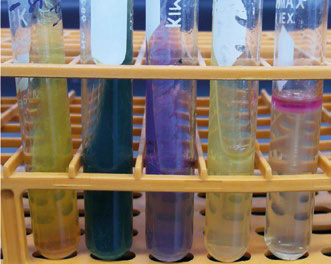
SEROTYPING
Serotyping has been used as a very useful tool for epidemiological purposes. In the case of this bacterium, the Kauffman-White scheme is used, similar to that of Salmonella, which is based on the identification of somatic “O”, capsular ‘K’ and flagellar “H” antigens.
In the case of E. coli, 197 somatic, 80 capsular and 60 flagellar antigens have been identified.
- When only the somatic antigen is referred to, it is called a serogroup, and
- When both the somatic and flagellar antigen are mentioned, then it is called a serotype.
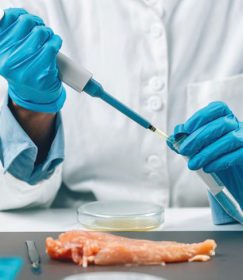
In the case of the “O” antigen, it is part of the lipopolysaccharide (LPS) that is part of the outer membrane of gram-negative bacteria, which is composed of lipid A, the inner core, outer core and side chains that are repeated polysaccharide units containing 2 to 5 sugar residues.
As is evident, the great diversity of the “O” antigen offers advantages to the bacterium to survive in specific niches, in fact, it is considered a very important virulence factor, not only for APEC strains, but also for ExPEC strains.
- Since it prevents the binding of host antibodies to antigens that are located in more internal structures in the bacteria, it is also known to prevent the binding of phages to membrane proteins; it has even been shown that this antigen is capable of inhibiting the enzymatic action of lysozyme.
On the other hand, the “O” antigen is highly immunogenic and is the main antigen against which the immune response is mounted, which represents a great challenge for the production of vaccines, because as mentioned, at least 197 antigens are recognized and between most of them there is no cross-protection.
- Until a few years ago, it was recognized that the most common serotypes among APEC strains were O1, O2 and O78.
- However, as more strains involved in poultry infections have been analyzed, it has been determined that serotypes vary depending on the geographic area, time of isolation, type of bird and location of infection.
Although serotyping can be very useful to relate certain serotypes to some disease outbreaks, as well as biochemical identification, it does not provide information on the virulence of the isolated strains.
- For this reason, various methods such as molecular methods have been used to define the virulence of a given strain.
ISOLATED STRAINS SEROTYPED
In Mexico, several studies have been carried out in which strains isolated between 1997 and 2019 have been serotyped, which were obtained from broiler breeders, layer breeders, hatcheries, broiler chickens, chicken carcasses in processing plants and points of sale, laying hens, backyard poultry and quails; a total of 1235 strains were serotyped, which are shown in Figure 2.
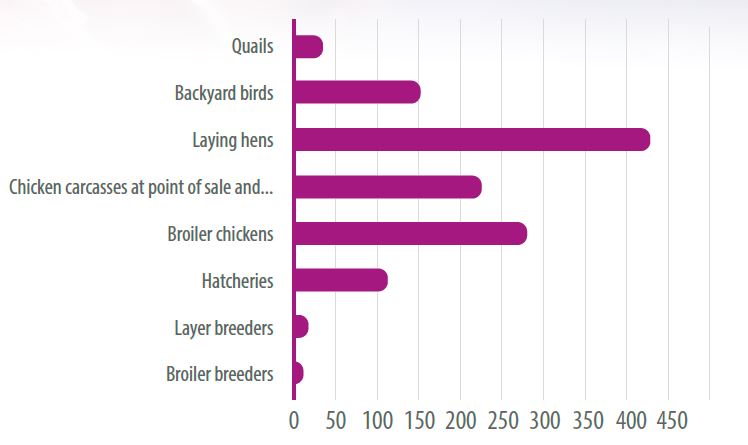
In total, 131 different serogroups were identified, of which 30 only one strain was identified, while the most frequent were the non-typeable strains, followed by strains O25, O8, rough strains, O2 and O82, as shown in Table 1.
- It can be seen that most of the serogroups found are not those traditionally reported as characteristic of APEC strains.
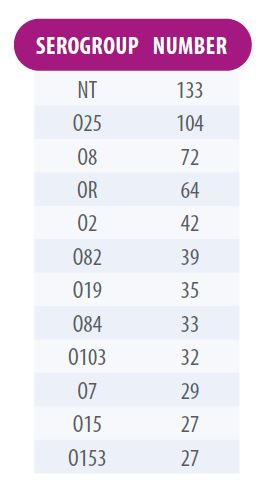
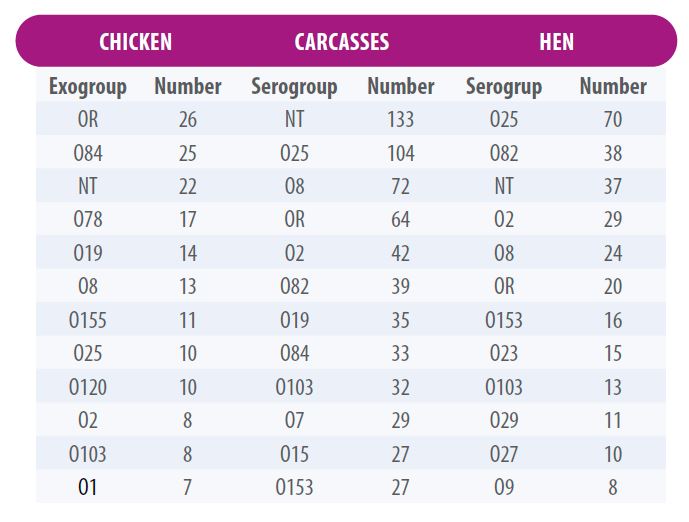
In addition, we compared the serogroups that were most frequently found in the samples for which we had the greatest number, as shown in Table 2.
- In this one you can see that O19 and O84 were common in broilers and broiler carcasses both at the point of sale and in processing plants;
- While in the case of strains O82 and O153, they were found in both carcasses and laying hens;
- Finally, serogroups common in chickens, carcasses and hens were found, such as O2, O8, O25 and O103, which could be considered as candidates for the development of an immunogen for the prevention of avian colibacillosis.

APEC INVOLVEMENT IN EXTRAINTESTINAL DISEASES
APEC strains have been implicated in a wide variety of extraintestinal diseases in different avian species, from localized infections, such as:
- Omphalitis, yolk sac infection, cellulitis, swollen head syndrome, diarrhea, venereal infections, salpingitis, salpingoperitonitis and peritonitis, orchitis and epididymitis;
- Systemic infections such as colisepticemia of respiratory origin, enteric, neonatal or sequelae of these infections such as meningitis, panophthalmitis, osteomyelitis, spondylitis, arthritis, synovitis and salpingitis, among others.
This same versatility has called into question whether the APEC group can actually be considered as a single pathotype or whether there are subpathotypes that are responsible for the different syndromes and therefore possess specific virulence genes that cause the clinical manifestations caused by E. coli in birds.
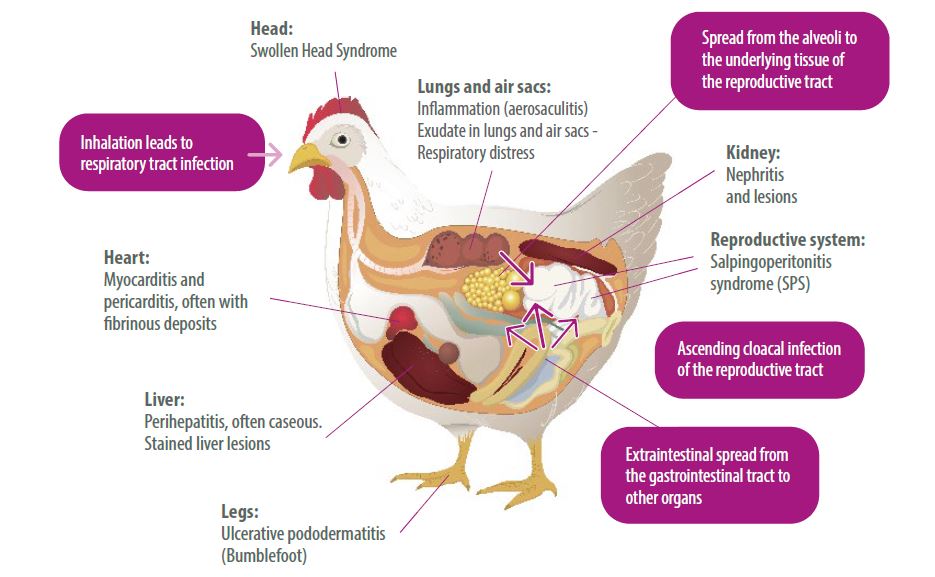
APEC’S ENTRY ROUTES
One of the main routes of entry of APEC is through the respiratory tract by inhalation of contaminated dust, for which adhesion to the trachea is a critical initial step in causing subsequent septicemia; an important structure in this process is fimbria type 1 which binds to the D-mannose residues of tracheal and pharyngeal epithelial cells via the adhesin FimH. It is known that bacterial isolates that colonize the trachea, lungs and air sacs commonly express fimbria type 1, while those that are capable of colonizing internal tissues or causing septicemia do not.
In contrast, strains that cause infections in air sacs, lungs or internal organs express P-type fimbria, whose adhesin PapG binds to the glycolipid galabiose; This adhesin has three allelic variants, of which most APEC strains are reported to possess PapGII.
- However, in a study in which different genes were detected in 30 strains of E. coli isolated from laying hens with peritonitis in the region of Los Altos de Jalisco, only one of them was positive for this gene, while 100% were positive for FimH.
OTHER CRITICAL FACTORS FOR E. COLI VIRULENCE
Other critical factors for E. coli virulence are iron acquisition systems through siderophores; it has been reported that 40% of APEC strains possess the aerobactin system, while it was only found in 30% of strains isolated from healthy birds.
- These virulence factors are regulated by bacterial communication systems (quorum sensing) through autoinducers, of which autoinducer 2 (AI-2) is widely distributed among several bacteria and plays a crucial role in the survival and formation of biofilms.
- There are two types of AI-2 receptors, LuxP and LsrB, both of which are able to bind AI-2 despite having a different structure; recently Zu et al. (2009) demonstrated that deletion of the lrs operon, composed of 8 genes, including lrsB, decreased virulence 294-fold in APEC strains as the amount of bacteria present in blood, liver, spleen, kidney, was significantly lower than in the wild-type strain.
Despite all the factors that have been described in APEC strains, Johnson et al. in 2008, after analyzing a significant number of virulence genes, concluded that most virulent strains possessed at least three of five genes that could be identified by a multiplex PCR test called pentaplex, as shown in Table 3.
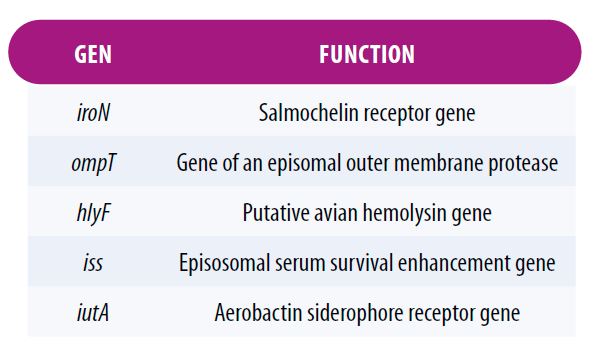
However, it is worth mentioning that in our laboratory we have found strains that have shown virulence in birds and in embryonic lethality tests that do not have them, which reinforces the idea of the existence of subpathotypes.
An example of this is found in the study by Maturana et al. who observed that strains isolated from different syndromes had some characteristics in common with each other, but differed from those found in other syndromes, suggesting that APEC is not a homogeneous pathotype.
These findings have led several groups around the world to study APEC strains, which will undoubtedly result in a better understanding of the virulence mechanisms and pathogenesis of APEC strains, and, consequently, in the design of better strategies to control the impact on the health of poultry flocks and the economic impact on poultry producers.
